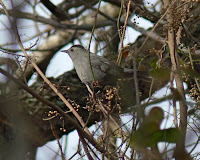 Gray Catbirds
Gray Catbirds are closely related to the
Northern Mockingbird. They're a little smaller and like to stay in low dense brush. They are migratory, and during the winter in Texas they usually only occur on the coast. But many Gray Catbirds are being seen further inland this season. I've seen one several times in our neighborhood since late December. It has always been on the flood plain property in the dense bushes west of the new footbridge. This morning I found it again and finally got these decent pictures of it. It was eating the berries around it which I think are Poison Ivy.

It sure was a beautiful morning today -- it was great to be outside and see the sun again. And I saw some great birds in addition to the catbird. On Broadmeade I ran into about a dozen
American Robins which I haven't seen much this winter. And I counted 92
Cedar Waxwings in several flocks throughout the morning. Near the Amber Oaks drainage pond across the creek, I was standing on the edge of a patch of woods when a
Great Horned Owl flew in and landed nearby. It was soon being harassed by
Blue Jays. On my way back home I ran into a great mixed flock of birds on Stillforest including:
I got this picture of one of the Orange-crowned Warblers.

 Gray Catbirds are closely related to the Northern Mockingbird. They're a little smaller and like to stay in low dense brush. They are migratory, and during the winter in Texas they usually only occur on the coast. But many Gray Catbirds are being seen further inland this season. I've seen one several times in our neighborhood since late December. It has always been on the flood plain property in the dense bushes west of the new footbridge. This morning I found it again and finally got these decent pictures of it. It was eating the berries around it which I think are Poison Ivy.
Gray Catbirds are closely related to the Northern Mockingbird. They're a little smaller and like to stay in low dense brush. They are migratory, and during the winter in Texas they usually only occur on the coast. But many Gray Catbirds are being seen further inland this season. I've seen one several times in our neighborhood since late December. It has always been on the flood plain property in the dense bushes west of the new footbridge. This morning I found it again and finally got these decent pictures of it. It was eating the berries around it which I think are Poison Ivy. It sure was a beautiful morning today -- it was great to be outside and see the sun again. And I saw some great birds in addition to the catbird. On Broadmeade I ran into about a dozen American Robins which I haven't seen much this winter. And I counted 92 Cedar Waxwings in several flocks throughout the morning. Near the Amber Oaks drainage pond across the creek, I was standing on the edge of a patch of woods when a Great Horned Owl flew in and landed nearby. It was soon being harassed by Blue Jays. On my way back home I ran into a great mixed flock of birds on Stillforest including:
It sure was a beautiful morning today -- it was great to be outside and see the sun again. And I saw some great birds in addition to the catbird. On Broadmeade I ran into about a dozen American Robins which I haven't seen much this winter. And I counted 92 Cedar Waxwings in several flocks throughout the morning. Near the Amber Oaks drainage pond across the creek, I was standing on the edge of a patch of woods when a Great Horned Owl flew in and landed nearby. It was soon being harassed by Blue Jays. On my way back home I ran into a great mixed flock of birds on Stillforest including:

2 comments:
I've heard birds are immune to the capsaicin in chili peppers. I wonder if they're also immune to poison ivy. I guess birds eating berries is a good way to explain why poison ivy always comes back eventually in even small brushy areas (like my mom's backyard).
-Eric
I think only humans are affected by Poison Ivy. Even other mammals are unaffected.
Post a Comment